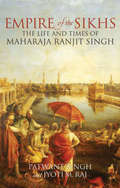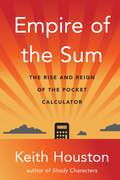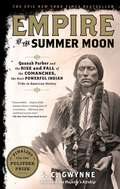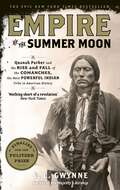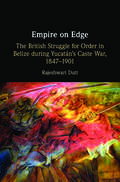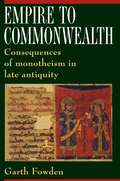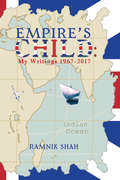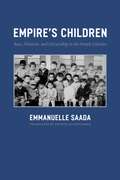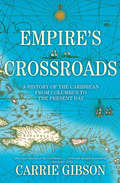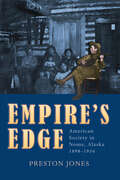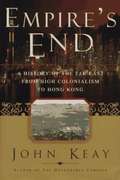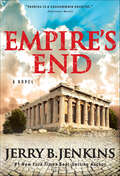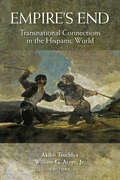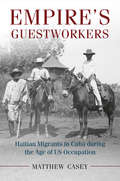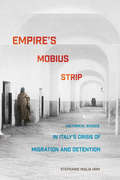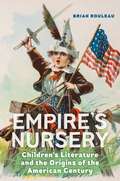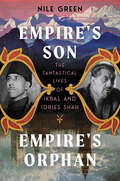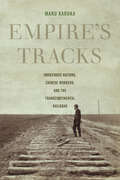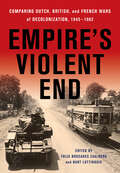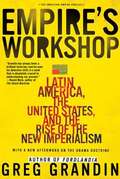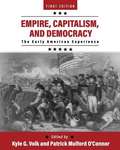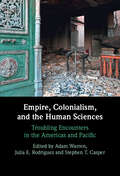- Table View
- List View
Empire of the Sikhs: The Life and Times of Maharaja Ranjit Singh
by Patwant Singh Jyoti M. RaiRanjit Singh has been largely written out of accounts of India's past by British historians, yet he was one of the most powerful and charismatic figures in Indian history. He unified the warring chiefdoms of the Punjab into an extraordinary northern empire, built up a formidable army, kept the British in check to the south of his realm, and closed the Khyber Pass through which plunderers had poured into India for centuries. His consummate humanity was unique among empire-builders. He gave employment to defeated foes, honored faiths other than his own, and included Hindus and Muslims among his ministers. A colorful character, he was inspired by the principles of peaceful coexistence uniquely articulated by the Sikh Gurus, firm in upholding the rights of others, and unabashed in exercising his own. The authors of this first full-length biography in English make use of a variety of eyewitness accounts, from reports by Maratha spies at the Lahore Durbar to British parliamentary papers and travel accounts. The story ends with the controversial Anglo-Sikh Wars following Ranjit's death, which saw the fall of his empire in the hands of his successors whose internecine conflict was exploited by the British. Coinciding with the 300th anniversary of the consecration of the Sikh holy scriptures, this book honors a vital figure in Sikh history.
Empire of the Sum: The Rise And Reign Of The Pocket Calculator
by Keith HoustonThe hidden history of the pocket calculator—a device that ushered in modern mathematics, helped build the atomic bomb, and went with us to the moon—and the mathematicians, designers, and inventors who brought it to life. Starting with hands, abacus, and slide rule, humans have always reached for tools to simplify math. Pocket-sized calculators ushered in modern mathematics, helped build the atomic bomb, took us to the bottom of the ocean, and accompanied us to the moon. The pocket calculator changed our world, until it was supplanted by more modern devices that, in a cruel twist of irony, it helped to create. The calculator is dead; long live the calculator. In this witty mathematic and social history, Keith Houston transports readers from the nascent economies of the ancient world to World War II, where a Jewish engineer calculated for his life at Buchenwald, and into the technological arms race that led to the first affordable electronic pocket calculators. At every turn, Houston is a scholarly, affable guide to this global history of invention. Empire of the Sum will appeal to math lovers, history buffs, and anyone seeking to understand our trajectory to the computer age.
Empire of the Summer Moon: Quanah Parker and the Rise and Fall of the Comanches, the Most Powerful Indian Tribe in American History
by S. C. Gwynne*Finalist for the Pulitzer Prize and the National Book Critics Circle Award* *A New York Times Notable Book* *Winner of the Texas Book Award and the Oklahoma Book Award* This New York Times bestseller and stunning historical account of the forty-year battle between Comanche Indians and white settlers for control of the American West &“is nothing short of a revelation…will leave dust and blood on your jeans&” (The New York Times Book Review).Empire of the Summer Moon spans two astonishing stories. The first traces the rise and fall of the Comanches, the most powerful Indian tribe in American history. The second entails one of the most remarkable narratives ever to come out of the Old West: the epic saga of the pioneer woman Cynthia Ann Parker and her mixed-blood son Quanah, who became the last and greatest chief of the Comanches. Although readers may be more familiar with the tribal names Apache and Sioux, it was in fact the legendary fighting ability of the Comanches that determined when the American West opened up. Comanche boys became adept bareback riders by age six; full Comanche braves were considered the best horsemen who ever rode. They were so masterful at war and so skillful with their arrows and lances that they stopped the northern drive of colonial Spain from Mexico and halted the French expansion westward from Louisiana. White settlers arriving in Texas from the eastern United States were surprised to find the frontier being rolled backward by Comanches incensed by the invasion of their tribal lands. The war with the Comanches lasted four decades, in effect holding up the development of the new American nation. Gwynne&’s exhilarating account delivers a sweeping narrative that encompasses Spanish colonialism, the Civil War, the destruction of the buffalo herds, and the arrival of the railroads, and the amazing story of Cynthia Ann Parker and her son Quanah—a historical feast for anyone interested in how the United States came into being. Hailed by critics, S. C. Gwynne&’s account of these events is meticulously researched, intellectually provocative, and, above all, thrillingly told. Empire of the Summer Moon announces him as a major new writer of American history.
Empire of the Summer Moon: Quanah Parker and the Rise and Fall of the Comanches, the Most Powerful Indian Tribe in American History
by S.C. GwynneIn the tradition of Bury My Heart at Wounded Knee, a stunningly vivid historical account of the forty-year battle between Comanche Indians and white settlers for control of the American West, centering on Quanah, the greatest Comanche chief of them all. Empire of the Summer Moon spans two astonishing stories. The first traces the rise and fall of the Comanches, the most powerful Indian tribe in American history. The second is the epic saga of the pioneer woman Cynthia Ann Parker and her mixed-blood son Quanah, who became the last and greatest chief of the Comanches. Although readers may be more familiar with the tribal names Apache and Sioux, it was in fact the legendary fighting ability of the Comanches that determined just how and when the American West opened up. Comanche boys became adept bareback riders by age six; full Comanche braves were considered the best horsemen who ever rode. They were so masterful at war and so skillful with their arrows and lances that they stopped the northern drive of colonial Spain from Mexico and halted the French expansion westward from Louisiana. White settlers arriving in Texas from the eastern United States were surprised to find the frontier being rolled backward by Comanches incensed by the invasion of their tribal lands. Against this backdrop Gwynne presents the compelling drama of Cynthia Ann Parker, a nine-year-old girl who was kidnapped by Comanches in 1836. She grew to love her captors and became infamous as the "White Squaw" who refused to return until her tragic capture by Texas Rangers in 1860. More famous still was her son Quanah, a warrior who was never defeated and whose guerrilla wars in the Texas Panhandle made him a legend. S. C. Gwynne's account of these events is meticulously researched, intellectually provocative, and, above all, thrillingly told.
Empire on Edge: The British Struggle for Order in Belize during Yucatan's Caste War, 1847–1901
by Rajeshwari DuttHow does Empire operate in frontiers and borderlands during times of conflict? Empire on Edge reveals how British officials attempted during the second half of the nineteenth century to understand and impose order on northern Belize, an area that was both a frontier of colonial power and the locus of a disputed border with Mexico. Their efforts were complicated by the local ramifications of Yucatán's Caste War (1847–1901), a long-lasting, violent struggle between segments of the indigenous Maya in southeast Mexico and the Mexican state. The book also illuminates how people subject to these efforts, especially the Hispanic and various Maya groups, sought to thwart them by building alliances across seemingly firm lines of racial and ethnic division. Along the way, important questions are raised about the dissonance between colonial and imperial projects, the nature of frontiers and borderlands, and the local effects of disputes between bordering countries.
Empire to Commonwealth: Consequences of Monotheism in Late Antiquity
by Garth FowdenIn this bold approach to late antiquity, Garth Fowden shows how, from the second-century peak of Rome's prosperity to the ninth-century onset of the Islamic Empire's decline, powerful beliefs in One God were used to justify and strengthen "world empires." But tensions between orthodoxy and heresy that were inherent in monotheism broke the unitary empires of Byzantium and Baghdad into the looser, more pluralistic commonwealths of Eastern Christendom and Islam. With rare breadth of vision, Fowden traces this transition from empire to commonwealth, and in the process exposes the sources of major cultural contours that still play a determining role in Europe and southwest Asia.
Empire's Child: The One Year Trip Into Unknown Territory (Hispanic Literature Ser. #Vol. 14)
by Ramnik ShahThis is a unique and varied collection of writings, spread over a half century, on wide-ranging subjects under the banner of a child of the British Empire. On its metropolitan home front, the Empire is of course long gone, with little left by way of folk memory. While it does not figure in our national conversation much, its legacy still lives on in many forms. More to the point, its historical significance is now being increasingly invoked and revived by writers with an immigrant background. This selective compilation falls into that genre. It is not a fictional narrative of a singular journey from out there to here, as it were, but rather a kaleidoscopic overview of the postcolonial movement into Britain of the East African (EA) Asians from a variety of historical, legal and cultural perspectives. This is encompassed in a mix of articles, magazine columns and other material and in the numerous letters in The Times and other newspapers. All these deal with different aspects of the whole EA Asian and indeed global migration phenomenon. Buried in there are snippets of the author's own trajectory from birth in colonial Kenya to eventual settlement in the UK. The texts also delve into his broad hinterland through an eclectic array of book and film reviews, blogs, travelogues and academic papers. Empire's Child provides a fascinating glimpse into the making of Britain's multicultural society.
Empire's Children
by Ellen BoucherBetween 1869 and 1967, government-funded British charities sent nearly 100,000 British children to start new lives in the settler empire. This pioneering study tells the story of the rise and fall of child emigration to Canada, Australia, New Zealand, and Southern Rhodesia. In the mid-Victorian period, the book reveals, the concept of a global British race had a profound impact on the practice of charity work, the evolution of child welfare, and the experiences of poor children. During the twentieth century, however, rising nationalism in the dominions, alongside the emergence of new, psychological theories of child welfare, eroded faith in the 'British world' and brought child emigration into question. Combining archival sources with original oral histories, Empire's Children not only explores the powerful influence of empire on child-centered social policy, it also uncovers how the lives of ordinary children and families were forever transformed by imperial forces and settler nationalism.
Empire's Children: Race, Filiation, and Citizenship in the French Colonies
by Arthur Goldhammer Emmanuelle SaadaEurope's imperial projects were often predicated on a series of legal and scientific distinctions that were frequently challenged by the reality of social and sexual interactions between the colonized and the colonizers. When Emmanuelle Saada discovered a 1928 decree defining the status of persons of mixed parentage born in French Indochina - the metis - she found not only a remarkable artifact of colonial rule, but a legal bombshell that introduced race into French law for the first time. The decree was the culmination of a decades-long effort to resolve the metis question: the educational, social, and civil issues surrounding the mixed population. Operating at the intersection of history, anthropology, and law, Empire's Children reveals the unacknowledged but central role of race in the definition of French nationality. Through extensive archival work in both France and Vietnam, and a close reading of primary and secondary material from the Pacific islands and sub-Saharan and North Africa, Saada has created in Empire's Children an original and compelling perspective on colonialism, law, race, and culture from the end of the nineteenth century until decolonization.
Empire's Crossroads: A History of the Caribbean from Columbus to the Present Day
by Carrie Gibson“Ever since Christopher Columbus stepped off the Santa Maria onto what is today San Salvador, in the Bahamas, and announced that he had arrived in the Orient, the Caribbean has been a stage for projected fantasies and competition between world powers. In “Empire’s Crossroads”, British American historian Carrie Gibson traces the story of this coveted area from the northern rim of South America up to Cuba, and from discovery through colonialism to today, offering a vivid, panoramic view of this complex region and its rich, important history. After that fateful landing in 1492, the British, French, Spanish, Portuguese, Dutch, Danish, and even the Swedes, Scots, and Germans sought their fortunes in the islands for the next two centuries. Some failed spectacularly: a poorly executed settlement in Panama led the Scots to lose their own independence to England. The Spaniards were the first to find prosperity, in Mexico but also along the islands. In Hispaniola, Cuba, and Puerto Rico, they built grandiose cathedrals and extracted shipfuls of gold and silver, which English, French, and Dutch pirates were happy to seize. But precious metals weren’t a sustainable export the colonizers needed something that was, and they would need hordes of slaves to cultivate it. The Caribbean’s first cash crop, one indigenous to the New World, was tobacco, and it, along with sugar, spurred expensive new addictions back in Europe. Gibson argues that immaterial exports were just as important. No other region of the world has experienced such a vibrant mixing of cultures, religions, and peoples Africans, Europeans, Asians, and Amerindians created amazingly dynamic Creole societies that complicated traditional ideas about class and race. By the end of the eighteenth century, seventy thousand free blacks and mulattos lived in the British islands alone, and it was in the Caribbean that the world’s only successful slave revolt took place sparking the meteoric rise of Napoleon’s black counterpart, Toussaint L’Ouverture, and the Haitian Revolution. The Caribbean island of St. Eustatius had been the first to recognize the United States as a nation, but the Americans were soon vying for their own imperial stronghold in the West Indies, attempting to control Cuba and backing influential corporations, most notably United Fruit. In the twentieth century, most of the islands broke from the imperial traditions that had lorded over them for four centuries: this would be the explosive age of decolonization and banana republics,” of racial riots and négritude, of Cold War politics and tourist crowds. At every step of her expansive story, Gibson wields fascinating detail to combat the myths that have romanticized this region as one of uniform white sand beaches where the palm trees always sway. Evocatively written and featuring a whole cast of cosmopolitan characters, “Empire’s Crossroads” reinterprets five centuries of history that have been underappreciated for far too long.
Empire's Edge: American Society in Nome, Alaska, 1898-1934
by Preston JonesIn 1898, Nome, Alaska, burst into the American consciousness when one of the largest gold strikes in the world occurred on its shores. Over the next ten years, Nome’s population exploded as both men and women came north to seek their fortunes. Closer to Siberia than to New York, Nome’s citizens created their own version of small-town America on the northern frontier. Less than 150 miles from the Arctic Circle, they weathered the Great War and the diphtheria epidemic of 1925 as well as floods, fires, and the Great Depression. They enlivened the Alaska winters with pastimes such as high-school basketball and social clubs. Empire’s Edge is the story of how ordinary Americans made a life on the edge of a continent—a life both ordinary and extraordinary.
Empire's End: A History of the Far East from High Colonialism to Hong Kong
by John KeayBritish colonial history.
Empire's End: A Novel
by Jerry B. JenkinsJerry Jenkins' surprising new novel is filled with adventure, drama, historic people and places, and even romance. Empire's End tells of a man who single-handedly turned the Roman Empire on-end. It will be the surprising, heart-stopping story of the year!
Empire's End: Transnational Connections in the Hispanic World
by Akiko Tsuchiya William G. Acree Jr.The fall of the Spanish Empire: that period in the nineteenth century when it lost its colonies in Spanish America and the Philippines. How did it happen? What did the process of the "end of empire" look like? Empire's End considers the nation's imperial legacy beyond this period, all the way up to the present moment. In addition to scrutinizing the political, economic, and social implications of this "end," these chapters emphasize the cultural impact of this process through an analysis of a wide range of representations—literature, literary histories, periodical publications, scientific texts, national symbols, museums, architectural monuments, and tourist routes—that formed the basis of transnational connections and exchange. The book breaks new ground by addressing the ramifications of Spain's imperial project in relation to its former colonies, not only in Spanish America, but also in North Africa and the Philippines, thus generating new insights into the circuits of cultural exchange that link these four geographical areas that are rarely considered together.Empire's End showcases the work of scholars of literature, cultural studies, and history, centering on four interrelated issues crucial to understanding the end of the Spanish empire: the mappings of the Hispanic Atlantic, race, human rights, and the legacies of empire.
Empire's End: Transnational Connections in the Hispanic World
by Akiko Tsuchiya William G. Acree Jr.The fall of the Spanish Empire: that period in the nineteenth century when it lost its colonies in Spanish America and the Philippines. How did it happen? What did the process of the "end of empire" look like? Empire's End considers the nation's imperial legacy beyond this period, all the way up to the present moment. In addition to scrutinizing the political, economic, and social implications of this "end," these chapters emphasize the cultural impact of this process through an analysis of a wide range of representations—literature, literary histories, periodical publications, scientific texts, national symbols, museums, architectural monuments, and tourist routes—that formed the basis of transnational connections and exchange. The book breaks new ground by addressing the ramifications of Spain's imperial project in relation to its former colonies, not only in Spanish America, but also in North Africa and the Philippines, thus generating new insights into the circuits of cultural exchange that link these four geographical areas that are rarely considered together.Empire's End showcases the work of scholars of literature, cultural studies, and history, centering on four interrelated issues crucial to understanding the end of the Spanish empire: the mappings of the Hispanic Atlantic, race, human rights, and the legacies of empire.
Empire's Guestworkers: Haitian Migrants in Cuba during the Age of US Occupation. (Afro-Latin America)
by Matthew CaseyInnovative study reconstructs Haitian guestworkers' lived experiences as they moved among the rural and urban areas of Haiti, and the sugar plantations, coffee farms, and cities of eastern Cuba. It offers an unprecedented glimpse into the daily workings of empire, labor, and political economy in Haiti and Cuba.
Empire's Mobius Strip: Historical Echoes in Italy's Crisis of Migration and Detention
by Stephanie Malia HomItaly's current crisis of Mediterranean migration and detention has its roots in early twentieth century imperial ambitions. Empire's Mobius Strip investigates how mobile populations were perceived to be major threats to Italian colonization, and how the state's historical mechanisms of control have resurfaced, with greater force, in today's refugee crisis.What is at stake in Empire's Mobius Strip is a deeper understanding of the forces driving those who move by choice and those who are moved. Stephanie Malia Hom focuses on Libya, considered Italy's most valuable colony, both politically and economically. Often perceived as the least of the great powers, Italian imperialism has been framed as something of "colonialism lite." But Italian colonizers carried out genocide between 1929–33, targeting nomadic Bedouin and marching almost 100,000 of them across the desert, incarcerating them in camps where more than half who entered died, simply because the Italians considered their way of life suspect. There are uncanny echoes with the situation of the Roma and migrants today. Hom explores three sites, in novella-like essays, where Italy's colonial past touches down in the present: the island, the camp, and the village.Empire's Mobius Strip brings into relief Italy's shifting constellations of mobility and empire, giving them space to surface, submerge, stretch out across time, and fold back on themselves like a Mobius strip. It deftly shows that mobility forges lasting connections between colonial imperialism and neoliberal empire, establishing Italy as a key site for the study of imperial formations in Europe and the Mediterranean.
Empire's Nursery: Children's Literature and the Origins of the American Century
by Brian RouleauHow children and children’s literature helped build America’s empireAmerica’s empire was not made by adults alone. During the nineteenth and twentieth centuries, young people became essential to its creation. Through children’s literature, authors instilled the idea of America’s power and the importance of its global prominence. As kids eagerly read dime novels, series fiction, pulp magazines, and comic books that dramatized the virtues of empire, they helped entrench a growing belief in America’s indispensability to the international order.Empires more generally require stories to justify their existence. Children’s literature seeded among young people a conviction that their country’s command of a continent (and later the world) was essential to global stability. This genre allowed ardent imperialists to obscure their aggressive agendas with a veneer of harmlessness or fun. The supposedly nonthreatening nature of the child and children’s literature thereby helped to disguise dominion’s unsavory nature.The modern era has been called both the “American Century” and the “Century of the Child.” Brian Rouleau illustrates how those conceptualizations came together by depicting children in their influential role as the junior partners of US imperial enterprise.
Empire's Son, Empire's Orphan: The Fantastical Lives of Ikbal and Idries Shah
by Nile GreenA rollicking story of two literary fabulists who revealed the West’s obsession with a fabricated, exotic East. In the highbrow literary circles of the mid-twentieth century, a father and son spread seductive accounts of a mystical Middle East. Claiming to come from Afghanistan, Ikbal and Idries Shah parlayed their assumed identities into careers full of drama and celebrity, writing dozens of books that influenced the political and cultural elite. Pitching themselves as the authentic voice of the Muslim world, they penned picaresque travelogues and exotic potboilers alongside weighty tomes on Islam and politics. Above all, father and son told Western readers what they wanted to hear: audacious yarns of eastern adventure and harmless Sufi mystics—myths that, as the century wore on and the Taliban seized power, became increasingly detached from reality. Empire’s Son, Empire’s Orphan follows the Shahs from their origins in colonial India to literary London, wartime Oxford, and counterculture California via the Levant, the League of Nations, and Latin America. Nile Green unravels the conspiracies and pseudonyms, fantastical pasts and self-aggrandizing anecdotes, high stakes and bold schemes that for nearly a century painted the defining portrait of Afghanistan. Ikbal and Idries convinced poets, spies, orientalists, diplomats, occultists, hippies, and even a prime minister that they held the key to understanding the Islamic world. From George Orwell directing Muslim propaganda to Robert Graves translating a fake manuscript of Omar Khayyam and Doris Lessing supporting jihad, Green tells the fascinating tale of how the book world was beguiled by the dream of an Afghan Shangri-La that never existed. Gambling with the currency of cultural authenticity, Ikbal and Idries became master players of the great game of empire and its aftermath. Part detective story, part intellectual folly, Empire’s Son, Empire’s Orphan reveals the divergence between representation and reality, between what we want to believe and the more complex truth.
Empire's Tracks: Indigenous Nations, Chinese Workers, and the Transcontinental Railroad (American Crossroads #52)
by Manu KarukaEmpire’s Tracks boldly reframes the history of the transcontinental railroad from the perspectives of the Cheyenne, Lakota, and Pawnee Native American tribes, and the Chinese migrants who toiled on its path. In this meticulously researched book, Manu Karuka situates the railroad within the violent global histories of colonialism and capitalism. Through an examination of legislative, military, and business records, Karuka deftly explains the imperial foundations of U.S. political economy. Tracing the shared paths of Indigenous and Asian American histories, this multisited interdisciplinary study connects military occupation to exclusionary border policies, a linked chain spanning the heart of U.S. imperialism. This highly original and beautifully wrought book unveils how the transcontinental railroad laid the tracks of the U.S. Empire.
Empire's Violent End: Comparing Dutch, British, and French Wars of Decolonization, 1945–1962
by Thijs Brocades Zaalberg Bart LuttikhuisIn Empire's Violent End, Thijs Brocades Zaalberg and Bart Luttikhuis, along with expert contributors, present comparative research focused specifically on excessive violence in Indonesia, Algeria, Vietnam, Malaysia, Kenya, and other areas during the wars of decolonization. In the last two decades, there have been heated public and scholarly debates in France, the United Kingdom, and the Netherlands on the violent end of empire. Nevertheless, the broader comparative investigations into colonial counterinsurgency tend to leave atrocities such as torture, execution, and rape in the margins. The editors describe how such comparisons mostly focus on the differences by engaging in "guilt ranking." Moreover, the dramas that have unfolded in Algeria and Kenya tend to overshadow similar violent events in Indonesia, the very first nation to declare independence directly after World War II. Empire's Violent End is the first book to place the Dutch-Indonesian case at the heart of a comparison with focused, thematic analysis on a diverse range of topics to demonstrate that despite variation in scale, combat intensity, and international dynamics, there were more similarities than differences in the ways colonial powers used extreme forms of violence. By delving into the causes and nature of the abuse, Brocades Zaalberg and Luttikhuis conclude that all cases involved some form of institutionalized impunity, which enabled the type of situation in which the forces in the service of the colonial rulers were able to use extreme violence.
Empire's Workshop: Latin America, the United States, and the Rise of the New Imperialism
by Greg GrandinIn a brilliant excavation of long-obscured history, Empire's Workshop shows how Latin America has functioned as a proving ground for American strategies and tactics overseas.
Empire, Authority, and Autonomy in Achaemenid Anatolia
by Elspeth R. M. DusinberreThe Achaemenid Persian Empire (550–330 BCE) was a vast and complex sociopolitical structure that encompassed much of modern-day Turkey, Syria, Jordan, Israel, Egypt, Iraq, Iran and Afghanistan and included two dozen distinct peoples who spoke different languages, worshipped different deities, lived in different environments and had widely differing social customs. This book offers a radical new approach to understanding the Achaemenid Persian Empire and imperialism more generally. Through a wide array of textual, visual and archaeological material, Elspeth R. M. Dusinberre shows how the rulers of the empire constructed a system flexible enough to provide for the needs of different peoples within the confines of a single imperial authority and highlights the variability in response. This book examines the dynamic tensions between authority and autonomy across the empire, providing a valuable new way of considering imperial structure and development.
Empire, Capitalism, And Democracy: The Early American Experience
by Patrick O'Connor Kyle VolkEmpire, Capitalism, and Democracy: The Early American Experience documents the history of the United States from the opening of the Atlantic World to the post-Civil War era. The primary sources included were created by women and men who lived during this time and illustrate three interdependent forces that animated the history of early America: empire, capitalism, and democracy. <p><p> Part I of the anthology explores the origins of European contact with America, "new world" civilizations, and the Atlantic slave trade. In Part II, students read sources that address American independence from British rule, early ideas of liberty and equality, the creation of the U.S. Constitution, and the first years of American government. The final part speaks to key issues that divided Americans in the nineteenth century, including market revolution, slavery, western expansion, and ideas of freedom and democracy after the Civil War. <p> With accessible introductions to each primary source and insightful questions to guide students' reading, Empire, Capitalism, and Democracy is an ideal collection for foundational courses in U.S. history.
Empire, Colonialism, and the Human Sciences: Troubling Encounters in the Americas and Pacific
by Adam Warren Julia E. Rodriguez Stephen T. CasperIn this bold reconsideration of the human sciences, an interdisciplinary team employ an expanded theoretical and geographical critical lens centering the notion of the encounter. Drawing insights from Indigenous and Latin American Studies, nine case studies delve into the dynamics of encounters between researchers, intermediaries, and research subjects in imperial and colonial contexts across the Americas and Pacific. Essays explore ethical considerations and knowledge production practices that prevailed in field and expedition science, custodial institutions, and governance debates. They reevaluate how individuals and communities subjected to research projects embraced, critiqued, or subverted them. Often, research subjects expressed their own aspirations, asserted sovereignty or autonomy, and exercised forms of power through interactions or acts of refusal. This book signals the transformative potential of Indigenous Studies and Latin American Studies for shaping future scholarship on the history of the human sciences. This title is also available as Open Access on Cambridge Core.
